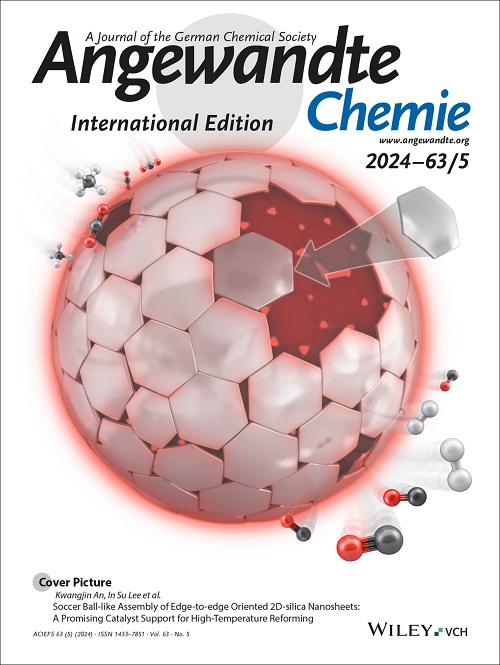Accelerated Proton-Coupled Electron Transfer via Engineering Palladium Sub-Nanoclusters for Scalable Electrosynthesis of Hydrogen Peroxide
IF 16.1
1区 化学
Q1 CHEMISTRY, MULTIDISCIPLINARY
引用次数: 0
Abstract
Electrosynthesis of H2O2 from oxygen reduction reaction via a two-electron pathway is vital as an alternative for the energy-intensive anthraquinone process. However, this process is largely hindered in neutral and alkaline conditions due to sluggish kinetics associated with the transformation of intermediate O2* into OOH* via proton-coupled electron transfer sourced from slow water dissociation. Herein, we developed Pd sub-nanoclusters on the nickel ditelluride nanosheets (Pd SNCs/NiTe2) to enhance the performance of H2O2 electrosynthesis. The newly-developed Pd SNCs/NiTe2 exhibited a H2O2 selectivity of as high as 99% and a positive shift of onset potential up to 0.81 V. Combined theoretical calculations and experimental studies (e.g., X-ray absorption and attenuated total reflectance-Fourier transform infrared spectra measurements) revealed that the Pd sub-nanoclusters supported by NiTe2 nanosheets efficiently reduced the energy barrier of water dissociation to generate more protons, facilitating the proton feeding kinetics. When used in a flow cell, Pd SNCs/NiTe2 cathode efficiently produced H2O2 with a maximum yield rate of 1.75 mmol h-1 cm-2 and current efficiency of 95% at 100 mA cm-2. Further, an accumulated H2O2 concentration of 1.43 mol L-1 was reached after 10 hours of continuous electrolysis, showing the potential for practical H2O2 electrosynthesis.通过工程钯亚纳米团簇加速质子耦合电子转移,实现过氧化氢的规模化电合成
通过双电子途径从氧还原反应中电合成 H2O2 是替代高能耗蒽醌工艺的重要方法。然而,在中性和碱性条件下,由于中间体 O2* 通过质子耦合电子传递从缓慢的水解离转化为 OOH* 的动力学过程缓慢,这一过程在很大程度上受到阻碍。在此,我们在二碲化镍纳米片(Pd SNCs/NiTe2)上开发了钯亚纳米团簇,以提高 H2O2 电合成的性能。新开发的 Pd SNCs/NiTe2 对 H2O2 的选择性高达 99%,起始电位正移高达 0.81 V。结合理论计算和实验研究(如 X 射线吸收和衰减全反射-傅立叶变换红外光谱测量)发现,由 NiTe2 纳米片支撑的钯亚纳米团簇有效地降低了水解离的能障,从而产生更多的质子,促进了质子馈入动力学。在流动池中使用时,Pd SNCs/NiTe2 阴极能有效地产生 H2O2,最大产率为 1.75 mmol h-1 cm-2,100 mA cm-2 时的电流效率为 95%。此外,在连续电解 10 小时后,H2O2 的累积浓度达到 1.43 mol L-1,显示了实用 H2O2 电合成的潜力。
本文章由计算机程序翻译,如有差异,请以英文原文为准。
求助全文
约1分钟内获得全文
求助全文
来源期刊
CiteScore
26.60
自引率
6.60%
发文量
3549
审稿时长
1.5 months
期刊介绍:
Angewandte Chemie, a journal of the German Chemical Society (GDCh), maintains a leading position among scholarly journals in general chemistry with an impressive Impact Factor of 16.6 (2022 Journal Citation Reports, Clarivate, 2023). Published weekly in a reader-friendly format, it features new articles almost every day. Established in 1887, Angewandte Chemie is a prominent chemistry journal, offering a dynamic blend of Review-type articles, Highlights, Communications, and Research Articles on a weekly basis, making it unique in the field.
文献相关原料
| 公司名称 | 产品信息 | 采购帮参考价格 |
|---|

 求助内容:
求助内容: 应助结果提醒方式:
应助结果提醒方式:


